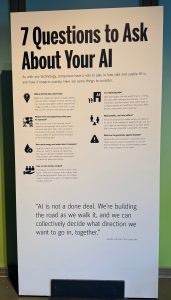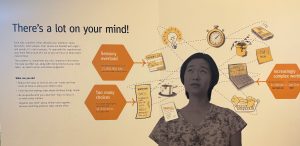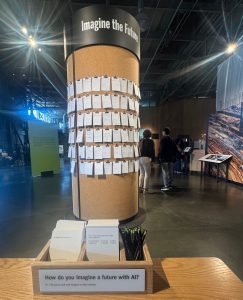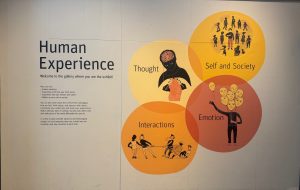Last weekend was Father’s Day and the kids took us to the Exploratorium! There is so much to see. They have galleries such as the Human Phenomena, Tinkering, Seeing & Reflecting, Living Systems, Outdoor Exhibits, and Observing Landscapes. On this visit, we spent our time in Adventures in AI.
My favorite part was participating in a round table discussion. The facilitator from Paradox Lab presented the ground rules (e.g., respect for each other, respect for the inquiry, being honest about their uncertainties) and then presented us with this question: “What would it take for a machine to genuinely see that a person is moving in front of it?”

Adventures in AI at the Exploratorium, San Francisco
The Hyperlinked Library model and participatory service concept is what came to mind as I explored this space with curiosity. The common denominator from the early modules points to emotional intelligence as the quotient that persuades people to work toward a common goal.

Adventures in AI at the Exploratorium, San Francisco
“Think about how you might encourage people to learn and be curious, to show them how things work, and show them how to find their way.”
—Michael Stephens
This theme stands out to me because I know how it felt to work in a command-and-control and toxic environment where the staff kept their heads down to avoid trouble. I am an Asian American female and grew up in San Francisco, and I have witnessed systemic unfairness.
Daniel Goldman (1995) describes in Emotional Intelligence of a survey of 250 executives written in Fortune in 1976 that most felt their work demanded their heads but not their hearts.” Many said they feared that feeling empathy or compassion for those they worked with would put them in conflict with the organizational goals (p.149).”
In the last four decades, I have seen examples of failed organizations and boiled frogs such as retailers like Blockbuster, Radio Shack, Blackberry, Toys R Us, or Borders. The good news is that workplace cultures continue to change, innovate, and stay relevant, including many libraries that are cultivating good relationships and values such as diversity, equity and inclusion.
The MLIS journey has provided me an opportunity to develop personally and professionally. Last semester, I had the privilege to work with my fellow MLIS classmates in writing a manuscript on the state of Artificial Intelligence in Public Libraries. This experience resembles what Mathews (2012) describes in Think Like a Startup: “with innovation it’s iteration, iteration, iteration. Your outlook should be to grow your idea by constantly building feedback into the developmental process”. Looking back on our ad hoc group, I learned the nuances of coordinating a team, building trust, being leaders, and seeing things from another perspective (as far as South Korea), and how those feedback loops created social harmony.
A tenet of the Five Laws of Library Science by Ranganathan states that the library is a growing organism, which highlights the need for libraries to be highly adaptable.
“This law acknowledges that libraries must continually evolve to meet the changing demands of society, whether through the adoption of new technologies, responding to shifts in user behavior, or expanding their services. It also speaks to the future of libraries, where flexibility and innovation are crucial in ensuring their relevance in an ever-changing information landscape.”
My adventure at the Exploratorium opened my mind to the possibilities for public libraries with an innovator’s mindset. This coordination requires initiative, self-motivation, and self-management, which are aspects of emotional intelligence. Their mission, vision, and values state:

Adventures in AI at the Exploratorium, San Francisco
Our mission is to create inquiry-based experiences that transform learning worldwide. Our vision is a world where people think for themselves and can confidently ask questions, question answers, and understand the world around them. We value lifelong learning, curiosity, and inclusion.
I interact with the public daily in my role at the library. I engage in conversations with library staff, too. I hear stories all day long about the lives and goings-on in my community. Yes, library 2.0 is about humans and storytelling, because it is a living organism. In Cluetrain Manifesto, Weinberger (2001) stresses that “stories are not a lot like information. But they are the way we understand”. In the same way, Casey, M. E., & Savastinuk, L. C (2007) instruct that “your organization will keep the Library 2.0 momentum going by encouraging your staff and customers to be a part of the process on a continual basis.” Mathews (2012) also agrees that this continuum requires “feeding the feedback loop”.

Adventures in AI at the Exploratorium, San Francisco
Remember the Paradox Lab question? “What would it take for a machine to genuinely see that a person is moving in front of it?” The way I see it, to “see” requires more than sight. Sometimes we hear, but do not understand. In the same way, seeing sometimes requires multiple senses and intelligences to understand and make sense of the world. This idea shapes my perspective on libraries, learning, and community.
References:
Casey, M. E., & Savastinuk, L. C. (2007). Library 2.0: A guide to participatory library service. Medford, N.J: Information Today.
“Five Laws of Library Science.” (2025). Lisedu Network. Retrieved June 22, 2025, from https://www.lisedunetwork.com/five-laws-of-library-science/
Goleman, D. (1995). Emotional intelligence: Why it can matter more than IQ. Bantam Books.
Mathews, B. (2012). Think Like A Start Up.
“Stephens, M. (2016). Chapter 1: “The Hyperlinked Librarian: Skills, Mind-Sets, and Ideas for Working in the Evolving Library” in The Heart of Librarianship: Attentive, Positive, and Purposeful Change
Weinberger, D. (2001). “The hyperlinked organization” in The Cluetrain Manifesto
